#Stink Bug Nymph
Photo
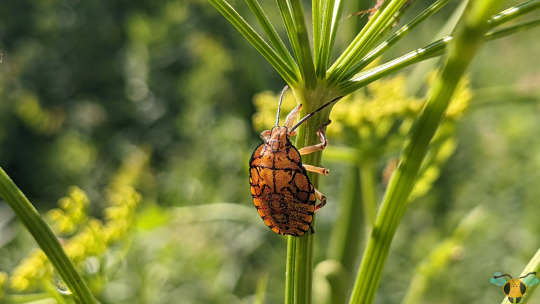
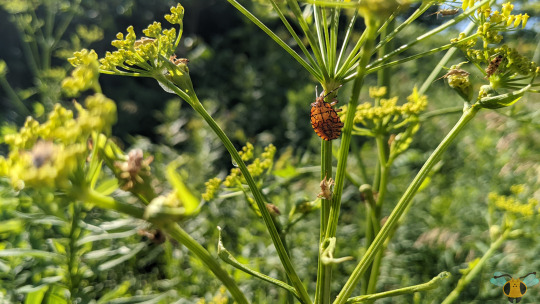




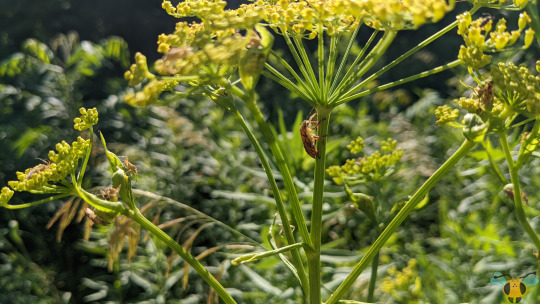



Predatory Stink Bug (nymph) - Apoecilus cynicus
My, my, out in the wilds of Kleinburg we find a wide and quite colorful insect! In an environment coated with tall and healthy greens, this nymph is a big stand out! While the large individual on display is the main focus of this post, the longer that you stare at these pictures, the more you’ll begin to see fellow Stink Bugs (and other miscellaneous Bugs) in the background. Certainly enough stem and flowers to go around for everyone and if my botany is correct, I believe that this Stink Bug is occupying wild parsnip! While the insects here can carefully navigate the plant’s flowers and (seemingly) tolerate the plant’s sap, humans aren’t so lucky. This plant’s sap is toxic, resulting in blisters on contact with the effects drastically amplified when exposed to light. Sometimes holding onto a plant to keep it steady in wind and/or bring it closer to the camera is needed for an insect picture, but this isn’t one of those plants to handle carelessly. I would advise caution when approaching this particular plant for insect observations and photography and to minimize skin contact where possible. With how humans react to the sap, it’s a miracle what these insects have grown to withstand in their environment...or perhaps they’re just very careful and observant to avoid danger.
Plant precautions handled, let’s examine our young orange insect more closely. As it’s a nymph, it lacks developed wings but will gain after its final molt. Though a spectacular shade of orange and decorated with intricate black lines and red dots, these markings will disappear with the final molt, replaced with a faded-brown exterior. It’s always fascinating the differences in exposed colors between nymphs and adult Stinkbugs. Not only that, but while adult Stink Bugs have a shield shape, the nymphs begin life more rounded. They gradually become more shield-like in appearance as they molt, and I dare say this one is fairly close to that pentagonal shape. As a growing Bug, it needs a food source, and while plants are generally the food of choice, this Stink Bug specie prefers feeding on any soft-bodied insects that it can find. Similar to the Spined Solider Bug (a close relative, both are different genera in the subfamily Asopinae - Predatory Stink Bugs), they use their rostrum to pierce and feed. It was only after actually looking at the photos that I noticed how big the rostrum on this nymph actually is! You could be forgiven for thinking the appendage was an extra leg beneath the head! Interestingly, the rostrum is so enlarged that these insects have difficulty keeping it folded under them as they travel. This one had better be careful as piercing the parsnip stem could yield disaster!
Pictures were taken on July 9, 2022 near Kleinburg village with a Google Pixel 4.
#jonny’s insect catalogue#ontario insect#stink bug#apoecilus stink bug#apoecilus cynicus#hemiptera#true bug#heteroptera#insect#july2022#2022#kleinburg#stink bug nymph#entomology#nature#invertebrates
5 notes
·
View notes
Text
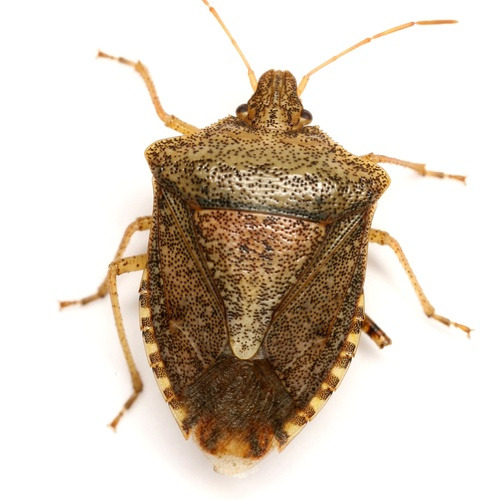

Which one's the brown marmorated stink bug (halyomorpha halys) and which is the brown stink bug (euschistus servus).
Quickly.
#Euschistus servus#halyomorpha halys#stink bug#bugs#insect#lol i always get asked this and like. bring it to me as a nymph next time you send me a 144p image. I can't even confirm it 100% in 4k
0 notes
Text
Egg update!!!!
THEYRE HERE

And not what I expected! I assumed they would hatch out as larvae (probably from the moths that hang around the porch light), but they're actually stink bug nymphs.
They're so rotund!
#bouncing baby bugs#stinkin cute#if you will#sorry for my atrocious camera work#bugs#insects#stink bug#insect eggs#stink bug nymphs
1 note
·
View note
Text


Four-humped Stink Bug (Brochymena quadripustulata) nymph, I believe. Like most insect thing i get decent pictures of it is missing a bit or 2, an antennae in this case at least
#nature#four humped stink bug#nature photography#stink bug#insect nymph#backyard nature#4 humped stink bug nymph#bug#insect
0 notes
Note
do you know what to do with all these molted cicada nymph shells
Sure, they're not dead, but they still give off the same vibe to me. You know? The empty casings of a spent thing? Dust gathering in the recesses where something used to be? Sure, they're not dead, but they still set off my Necroentomophobia. Fear of dead bugs! Did you know that?
Did you know people could be scared of dead bugs? Whatever.
It's not the same as being scared of a bug, sure. But I can be scared of a lot of bugs. Sure, little things, like the humble lady bug- not scary. Butterflies, scant as they are, are only off-putting to me. The beautiful moth? Well, I love it, but I don't want to hurt it. It's whimsical, fat body makes me nervous. I don't want to squish it by accident! Because then it would be a dead bug.
And that's worse.
It's like, not precisely a direct fear of a dead bug. It won't leap at me in a defiant rage, or be waiting for me around the scary corner. It's more like a shortcut to existential dread. It's a combination of 'ew!' and 'I am going to die one day' and more importantly, if a bug is dead, something has killed it. And you never know if that something is still lurking around. Just kidding.
Do you know what a cicada shell is made of? That's right. It's the happy chitin! I don't have an issue with chitin. We're not chitinous beasts, but we have the enzymes to break them down. Humans, that is. This isn't a science fiction piece. This is my blog.
I've always thought chitin was interesting though- it's a natural armor made for little guys ostensibly. Little guys in the sense, that it is for bugs only. Well, crabs have chitin, and they can get pretty big- The spider crab can grow over 300 feet in diameter. Just kidding, it can't do that. It's pretty big though.
At this point, you'd think: 'Okay- crab reference, and a direct link to the enzymes to break down chitin. Do we eat them? Should we eat the Cicada shells?' Well, I'm not going to. That sounds kind of scary to me. Would you? Would you eat the shell of a thing? I can't imagine it tastes good.
I'm eating potato chips right now.
They're yummy, and crunchy, and in many ways- the opposite of the humble cicada's false corpse. A lying bug. A lying, cheating, swarming thing. A bug we don't like. A bug we have to deal with. Don't we have to deal with everything? Would it be easier to show less mercy to the little things? It wouldn't, and it would be mean.
And that's worse.
Anyway, to answer your question, you turn them into mulch, apparently. Or bury them in a hole. Through my research, those were the only two real options we have. There's also 'add them to compost.' So that's three, you have three options. Do you want my opinion? No?
Moving on then.
There's also a fourth option- a telling one, at that. A sort of 'secret option' lots of people choose. 'Let them decompose on your lawn.' Right? Right, the easy one? Might as well call it 'do nothing.' Doing nothing is always a choice, sure, but when you give me the choice to 'do nothing' in a game, or choose your own adventure, it always seems like a lazy choice on the developer's part. And sure, from your real life perspective, it's probably the easiest. But from a game design perspective? You have to account for the player sitting and watching.
What happens if I don't intervene? What happens if I let it continue?
Well, in the case of the empty cicada, they stink apparently. I've never noticed it, and we have cicadas here- but I've been lucky enough to never be out in or see a swarm. A predecessor of mine once recalled a story in which the swarm was so bad, you couldn't walk outside without crushing them on the sidewalks
"Ew," is what I thought.
Maybe they only smell if there's hundreds of them. Thousands? No, probably just hundreds. Not saying they wouldn't smell more if there were lots, I'm saying they probably start being noticeable at around a hundred. Nothing wrong with that. Not sure what the smell is, though. Do you?
You should put them in a hole.
345 notes
·
View notes
Photo

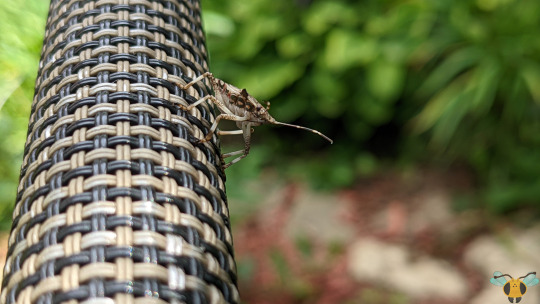

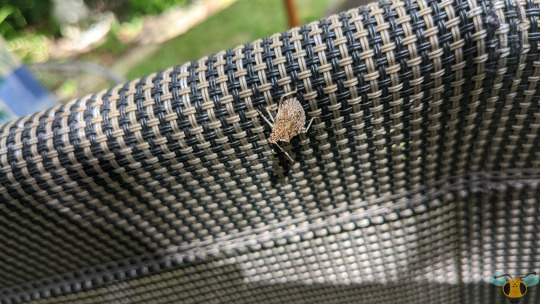



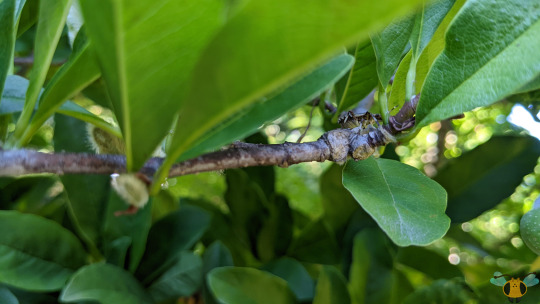


Brown Marmorated Stink Bug (nymph) - Halyomorpha halys
This insect is approaching its adult stage where it will receive its wings and be able to fly around wherever it pleases (as long it has the energy to do so). Before that molt, it will have to rely on running to get where it needs to go, and so I have a small story to share with this individual. My mom was the one who actually found the insect at first and called me to see it. The young Stink Bug was seemingly trying to blend in with the patterns on the recliner to stay hidden while soaking in the sun. I picked it up to get a closer look and when done, placed it on the leaves seen in the pictures. It scampered up the leaf and down the stem. A few minutes pass, and the Bug is back on the top of the chair! Later, my mom picked it up and put it on the soil while tending to the yard’s plants. A few minutes later, it’s back on the chair! This is honestly astounding to me. It knew exactly where to go and got there very quickly. The running is fascinating enough, but the insect still needs to know where it’s going in order to get there. As I understand, Stink Bugs have reasonable vision to navigate the world, but I also think that his individual may have relied on environmental cues or scents to find its way back to the chair.
Since insect antennae function in some ways like noses, they may have been the key to finding that sunny spot. Not only are those antennae handy from sniffing the world, they are also handy for confirming the identity of the insect. Those alternating bands of black and white (one long, one short) are easily noticeable from the second instar all the way up to adulthood. Look for the bands and a mottled look across the abdomen and slight darkening at the leg joints. The nymphs also feature pairs of little yellow spots across their back which mostly disappear after the adulthood molt. Likely, this individual will reach that final molt around mid-August at the very latest. The new generation of adult Stink Bugs will then enjoy the summer and early autumn until conditions grow too cold. They will hideaway to overwinter and emerge in the spring to lay eggs and continue their own circle of life. However, sometimes the insides of homes (especially attics) is far more comfortable for them to wait out the winter than the outdoor soil. Keep an eye on your home’s nooks and crannies as winter approaches as a Stink Bug infestation can be quite a nuisance, especially to indoor. Fortunately, they are harmless to humans outside of their stink defenses.
Update (August 12, 2022): 3 more pictures have been added. In pictures 8-10, the nymph has darker coloration along the leg joints and was found probing the magnolia tree’s seed pods. With its mottled colors, it blends into the tree’s bark easily, but the underside color doesn’t match at all.
Pictures were taken on July 30 and August 12, 2022 with a Google Pixel 4. No humans or chairs were stunk up in the making of these pictures.
#jonny’s insect catalogue#ontario insect#stink bug#brown marmorated stink bug#brown marmorated stink bug nymph#true bug#hemiptera#heteroptera#insect#toronto#july2022#2022#stink bug nymph#august2022#entomology#nature#invertebrates
2 notes
·
View notes
Text
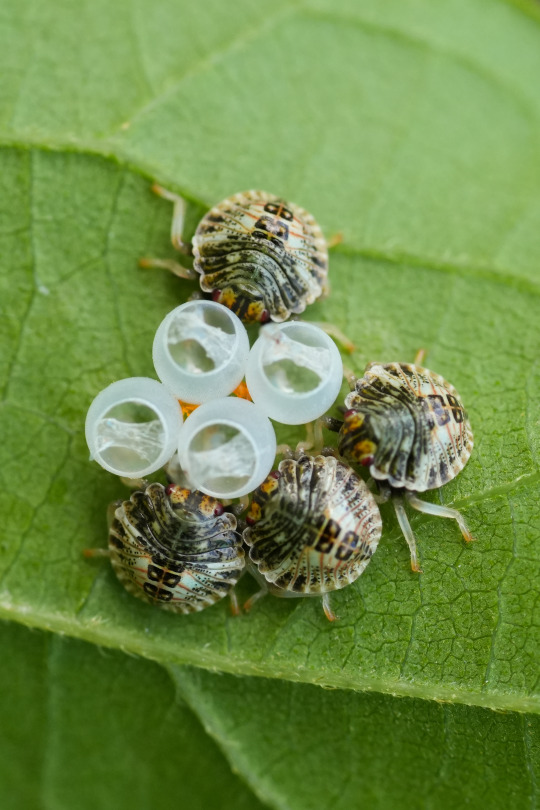
babies!!
Unknown Stink Bugs, nymphs, 4 individuals (family Pentatominae).
#ljsbugblog#bugblr#entomology#macro#insects#hemiptera#heteroptera#true bugs#pentatomidae#stink bugs#unconfirmed ID
98 notes
·
View notes
Text
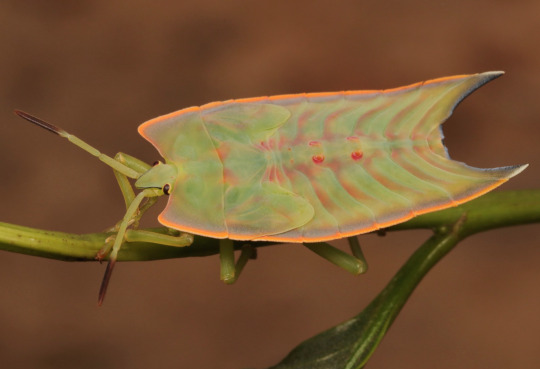

Giant Shield/Stink Bug Nymph (Tessaratomidae)
#bugs#insects#naturecore#Tessaratomidae#stink bug#photography#nature#green#i love them!!#Entomology#shield bug#1k
1K notes
·
View notes
Text
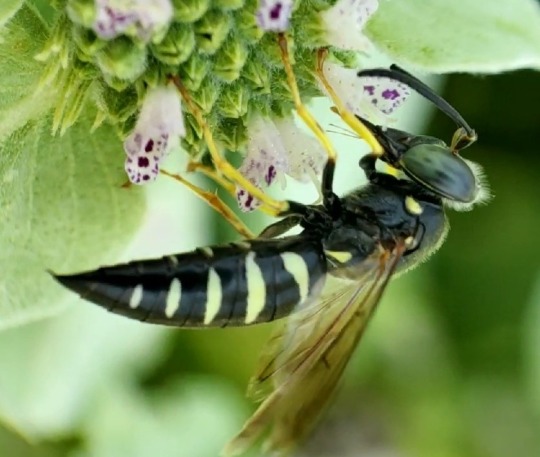
Four-banded stink bug wasp (Bicyrtes quadrifasciatus), a type of sand wasp, in central Pennsylvania.
Sand wasps are called that because they like to lay their eggs in burrows they dig in sand. The female of this species hunts for hemiptera (true bug) nymphs, mainly stink bugs, which she stings and paralyzes. She carries the still living nymphs back to the nest where she lays her eggs. After it is well-stocked with victims, she seals it off. Her larvae will eat the paralyzed nymphs when they hatch.
The adults eat nectar and are pollinators. They can also help with invasive species control, assuming it's a species their larvae would find appetizing.
Here’s another one I found nearby digging a nest:
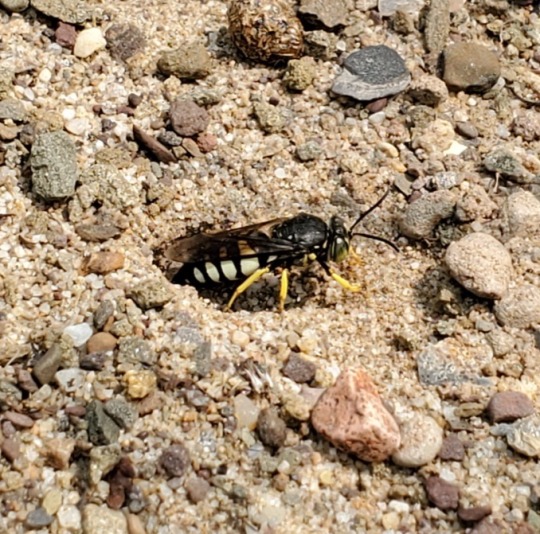
#wasp#wasps are cool#stink bug wasp#Bicyrtes quadrifasciatus#sand wasp#Penn State arboretum#four-banded stink bug wasp#buzz buzz#hymeoptera#Pennsylvania#nature#bugs#nature photography#biodiversity#animals#inaturalist#arthropods#bugblr#insect appreciation#entomology#wasp appreciation#no wasp hate here please#pollinators#support native pollinators#invertebrates#insects#interesting facts#science#fun facts#biology
20 notes
·
View notes
Text
December 11th, 2023
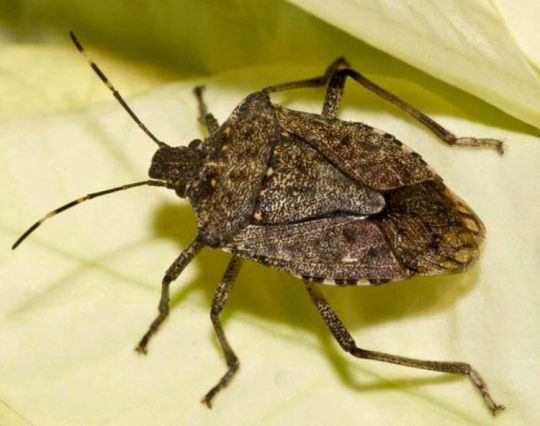

Brown Marmorated Stink Bug (Halyomorpha halys)
Distribution: Native to east Asia; China, Japan and Korea; introduced to Europe, Eurasia, South America and North America.
Habitat: Often associated with human habitats, found in or near homes and vehicles; also found in agricultural fields, gardens and orchards.
Diet: Generalist herbivore; feeds on the juices of plants, with a preference for fruit, but will also feed from leaves and tree trunks; preference for fruiting plants.
Description: These crop pests were introduced to the USA sometime in the 90s, first detected in Pennsylvania. It was likely introduced to Europe in 1998, and later made its way to South America and Eurasia. This species is responsible for damages on many types of crops, costing thousands of dollars in damages to apple and stone fruit crop in the USA, as well as extensive damage to hazelnut crops in Turkey and Georgia. The brown marmorated stink bug may also enter homes when the weather gets cold, sometimes into the thousands per household.
Like many other stink bug species, the brown marmorated stink bug has the capacity to produce a foul odor when it's disturbed, often compared to that of cilantro. This smell is used as a defence mechanism against vertebrate predators like birds and lizards. While it's rarely harmful to humans, the stink bug's fluid is an irritant that may cause inflammation on the skin or in the eyes.
(Images by Susan Ellis (adult) and David R. Lance (nymphs))
30 notes
·
View notes
Note

Hey, could you tell me what these little guys are? They showed up on my end-of-season salmon berries and all iNat will tell me is they're insects, which REALLY isn't helpful. I live in the Pacific NW, btw. Specifically Portland Metro area
nymphs of these, I think!
35 notes
·
View notes